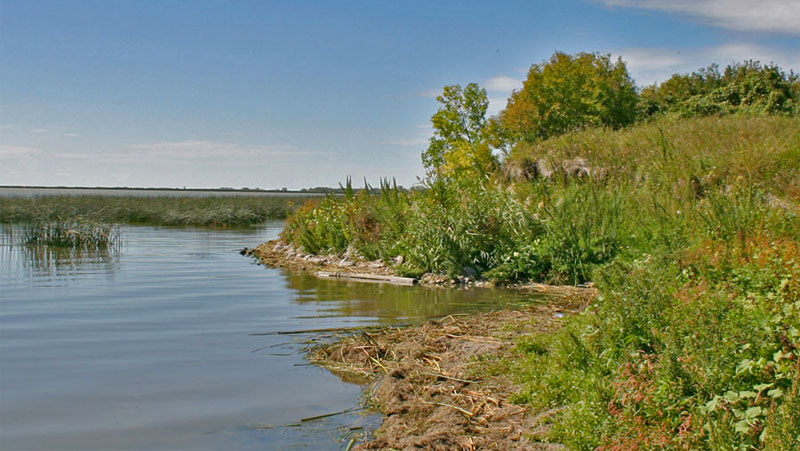|


2. First Peoples
& First Nations

We
know that Manitoba has been home to many cultures, and on trading
routes that connected those cultures to others far distant from here.
By the 1700’s when explorers from New France began showing an interest
in this region, it was often visited by hunters from Nakota
(Assiniboine), Dakota (Sioux), Cree, and Ojibway people.
It was the Nakota, whom LaVerendrye encountered on his trips in 1838
and afterwards.
Over the centuries various cultures developed better weapons and
sharper tools. They learned to use all parts of a buffalo carcass to
provide food, clothing, shelter and tools. They developed hunting
methods, relying on stealth, marksmanship, camouflage, and finally the
mass killing fields allowed by pounds and jumps. They got really good
at harvesting and using the most readily available resource on the
plains.
A successful society is able to offer its people a fair chance at
health and happiness.
Plains cultures were successful – for many centuries.
A recent book bears the title “1491”and presents us with a look at
North and South America at that point. It was at that date, a territory
largely untouched by the rest of the world. Yes, the Vikings had
visited the northern reaches of the continent, but they had retreated
without very much readily apparent or lasting impact.
What was life like on the Canadian Plains at that time?
In western Manitoba a series of cultures had developed great skill in
hunting and using the buffalo for food, shelter, clothing and
tools.
Elsewhere in North America the Inca, Mayan and Aztec civilizations of
Central and South America had erected large cities. The Anasazi,
or Ancient Pueblo Peoples were building cliff dwellings in Utah,
Colorado, Arizona and New Mexico. To the east the Iroquois and Huron
civilizations flourished in their large villages.
The north-central plains were one spot in North America were
agriculture, specifically cultivating the soil, wasn’t important. It
was the development of agriculture that prompted civilizations around
the world to transfer from the nomadic lifestyle of the hunter-gatherer
to the village lifestyle of the farmer.
It turns out that the people here had pretty good reasons for their
mobile lifestyle. It worked for them.
The climate often wasn’t really suitable for agriculture, and the
demands of planting, nurturing and harvesting crops keeps one fairly
close to home. Ask an older farmer how many holidays he had in his
younger days.
To the European observer, the lifestyle of the Plains People was deemed
unsophisticated, lacking in creature comforts. Perhaps they were
overlooking that in Europe alongside incredible wealth, the majority
lived in crowded disease-ridden communities, faced malnutrition,
ongoing wars and plagues. Europeans liked to consider the mobile
lifestyle “improvident” and claimed it carried an unnecessary risk of
food shortages. Even the relatively recent famine caused by the potato
blight, which claimed about a hundred thousand lives across northern
Europe in the late 1840’s, should cause us to question that viewpoint.
Had those visitors (invaders) from Europe not been so convinced that
their way of life, their religion, their method of government, was the
one true path, as ordained by their God, what they would have
discovered in the Americas was a land peopled with a variety of
cultures that each, in its own way, had developed strategies for living
on this land. Those strategies varied as the land varied. Some lived in
villages and grew crops, some were hunters who adapted to the
availability and habits of their prey. Some used multiple strategies –
some were very dependent on one particular resource.
The problem was, that when you view a foreign people through eyes that
have been convinced of your own superiority, you don’t really see them.
You don’t even think it matters if you see them.
And should you look - you see what you want to see.
Until recently everything we were taught in schools about the people
who inhabited this continent had been filtered through the eyes of
people who saw what they wanted to see, and filtered through a system
that decided what they wanted us to know.
So what we need to do is re-learn what we thought we knew
Another myth about the Plains Lifestyle was that it increased the
likelihood of war. Any reading of European history in the centuries
surrounding 1491 will reveal uncountable wars and uncountable deaths.
Then there were periodic diversions such as the Spanish
Inquisition.
It should come as no surprise that everything that European newcomers
reported about this new land was, of course, filtered through their
worldview. “1491” is one of several recent attempts to put some balance
into the interpretation of the North American story.
Life on these plains was simpler, but a case can be made that the
majority of people were happier, healthier and less oppressed than the
average European.
They had adapted to their surroundings. The hunter-gatherer lifestyle
was the logical choice for the time and place. In other places,
and at other times, other strategies were needed.
There is evidence, recently discovered in Southwestern Manitoba and
previously noted in the Selkirk area, that agriculture was practiced
for a time in our area, but by the time of contact, however, European
visitors didn’t perceive signs of either village life or domesticated
crops on these Plains.

This
marshy shoreline along Oak Lake was a favorite kill site over 1000
years ago. The McKean People would drive buffalo into the marsh where
they could more easily kill them with spears.
Sources:
Re-examination of the Plains Woodland Snyder II site, SW Manitoba.
Scott Hamilton. Leigh Syms, Terry Gibson. Lakehead University Manitoba
Museum Alberta Western Heritage
Weatherford, Jack. Indian Givers, Broadway Books, 1989
Mann, Charles C. 1491: New Revelations of the Americas Before Columbus,
Vintage Books, 2011
Neufeld, Teyana, The Brockinton Site, Vantage Points
|
 |
 |
|
|